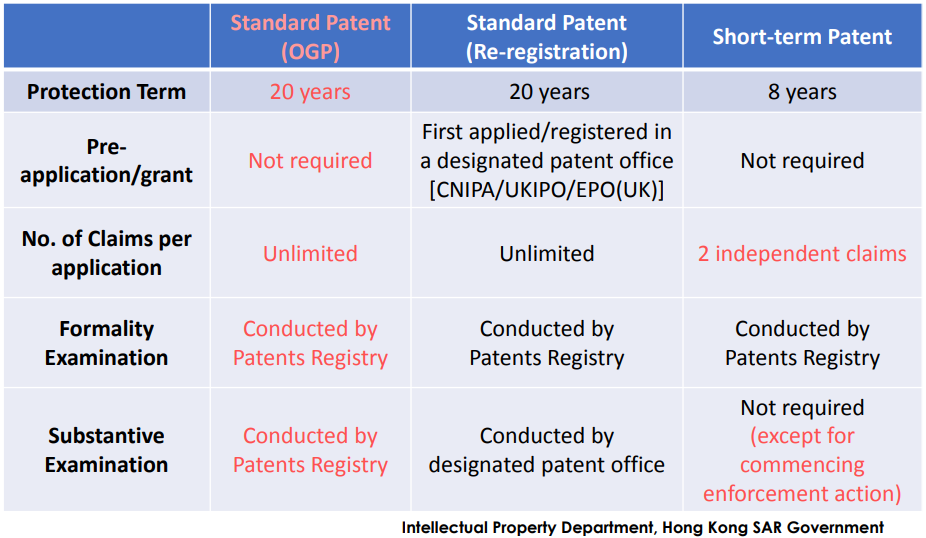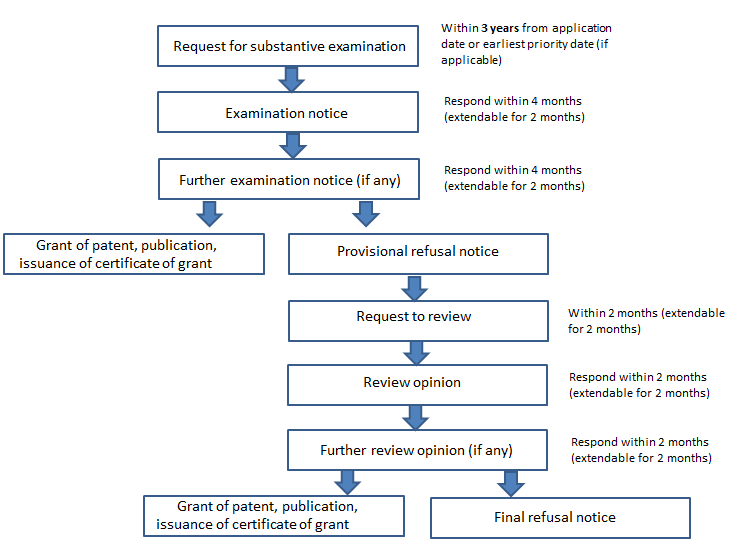1. Introducing an original grant patent (OGP) system
An OGP system is introduced for standard patents while maintaining the existing "re-registration" patent system. Previously, in order to pursue standard patents in Hong Kong, the applicant had to firstly file the patent application with one of the three designated patent offices, namely, China National Intellectual Property Administration (CNIPA), United Kingdom Patent Office (UKPO), and European Patent Office (EPO), and then have it registered in Hong Kong through a two-step registration procedure.
Under the new OGP system, applicants can choose to directly file an OGP with the Hong Kong Intellectual Property Department (HKIPD) without first filing in the three designated countries. The new OGP system is beneficial to applicants in that it offers an alternative and independent route for the applicants to seek standard patents in Hong Kong. Applications for standard patents filed under the OGP route can be filed in Hong Kong either with a claim to priority or as a first filing. The specification of the standard patent applications may be filed in English or Chinese.
A comparative table showing main features of different types of patents that may be granted in Hong Kong under the new patent system is provided below.

An OGP application is subject to, in addition to formality examination, substantive examination by the Patents Registry for determining the patentability of the invention. During substantive examination, the Registry examines whether the application complies with the examination requirements including novelty, inventiveness and industrial applicability. The procedures for substantive examination under the OGP route are outlined as below.

It is observed that the substantive examination procedures under the OGP route are highly similar to invention patent examination procedures in China. This includes for example the time frame for requesting examination, and the window for responding to examination reports. Note that, unlike the patent systems in United Kingdom or European Patent Office, there will be no separate search report issued for the OGP patent application that would otherwise provide the applicant with a chance to consider the merit of requesting examination. The request to review procedure after the issuance of provisional refusal notice also substantially resembles the re-examination procedures in CNIPA.
HKIPD will outsource part of the substantive examination for the OGP patent applications to CNIPA as an interim arrangement. The examiners from CNIPA will provide technical opinions relevant to the novelty and inventive step of the claimed invention, while HKIPD will prepare the examination notice in view of CNIPA’s technical opinion and based on the Patents Ordinance in Hong Kong.
According to the new patent system, applicants can choose an appropriate option to file standard patents in Hong Kong. For example, applicants may choose the OGP route when they have no interest in filing patent application with the designated countries outside Hong Kong, which helps reduce the patenting costs and time for obtaining standard patents in Hong Kong.
2. Refining the existing short-term patent (STP) system
Previosly, the number of independent claims allowed in a short-term patent application was limited to only one. Under the new patent system, a short-term patent application may contain up to two independent claims, provided that the two independent claims are related to one single inventive concept. This change allows applicants to seek protection of the product and the process of an invention in one short-term patent application. It offers cost-effectiveness and easier management in filing and maintaining the application for applicants.
In addition, short-term patents may be subject to post-grant substantive examination by the Registry (upon request by its proprietor or a third party having reasonable grounds/legitimate business interests) for determining the validity of the patent. In order to enforce a short-term patent, its proprietor must file a request for substantive examination of the patent with the Registry before commencement of enforcement action. A proprietor of a short-term patent must, when threatening a person with infringement proceedings, provide that person with the adequate information to identify the patent upon request by that person. The refined short-term patent system highly resembles the Australian innovation patent system in which an innovation patent is only legally enforceable if it has been examined by the Australian patent office, and examination of an innovation patent only occurs if requested by a patent proprietor or a third party.
3. Regulatory measure regarding patent practice in Hong Kong
The new patent system introduces an interim regulatory measure, which prohibits the use of confusing or misleading titles/descriptions including "registered/certified patent agent" and "registered/certified patent attorney". Use of titles/descriptions of any qualifications lawfully obtained from patent practice elsewhere is permitted as long as the jurisdiction where the qualification was obtained is clearly indicated.
Benefits of the new patent system
The new patent system helps promote filing flexibility. For example, standard patent applicants may choose to use the OGP or the re-registration route according to their individual business needs. This also helps reduce the patenting costs and time for obtaining standard patents in appropriate cases. The introduction of post-grant substantive examination safeguards against potential abuse of the system thereby enhancing its integrity while maintaining the overall cost-effectiveness of seeking short-term patent protection in Hong Kong. The regulatory measure concerning titles or descriptions relating to patent practice paves the way for Hong Kong to introduce a full-fledged regime on regulating local patent practitioners in the long term.


